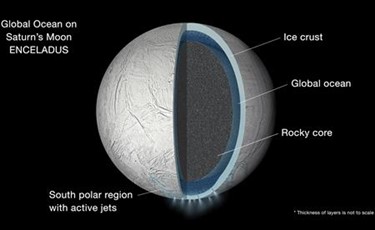NASA To Deploy Submillimeter-Wave Instrument To Study Icy Plumes Of Enceladus
By Jof Enriquez,
Follow me on Twitter @jofenriq

NASA is planning to send a new type of submillimeter-wave instrument to Saturn's moon, Enceladus — an instrument that can detect a wide array of chemicals and molecules in the plumes of water vapor shooting out of cracks in that moon’s icy surface.
The device, called Submillimeter Enceladus Life Fundamentals Instrument (SELFI), is said to be better than current state-of-the-art submillimeter-wavelength instruments in measuring tiny quantities of water and trace amounts of gases, such as those emanating from Enceladus' surface vents.
The submillimeter-wave, or terahertz, part of the electromagnetic spectrum, falls between the frequencies of 0.3 THz and 3 THz, and lies between the microwave and infrared regions. Astronomers are using the terahertz region of the spectrum to look for the chemical fingerprints of different kinds of molecules present in planets and their icy moons.
“Submillimeter wavelengths, which are in the range of very high-frequency (VHF) radio, give us a way to measure the quantity of many different kinds of molecules in a cold gas. We can scan through all the plumes to see what’s coming out from Enceladus,” said SELFI Principal Investigator Gordon Chin. “Water vapor and other molecules can reveal some of the ocean’s chemistry and guide a spacecraft onto the best path to fly through the plumes to make other measurements directly.”
NASA says SELFI will be improved by a more energy-efficient and flexible radio frequency (RF) data-processing system, as well as a sophisticated digital spectrometer that can convert RF signals, to measure the plumes’ gas quantities, temperatures, and velocities. The SELFI team also added an amplifier to boost the signal in the region around the 557 GHz frequency that has the strongest signal from water.
Because of these enhancements, the SELFI instrument will be able to differentiate and analyze up to 13 types of molecules, including water in various isotopic forms, methanol, ammonia, ozone, hydrogen peroxide, sulfur dioxide, and sodium chloride, according to NASA.
“Molecules such as water and carbon monoxide, and others, are like little radio stations that broadcast on very specific frequencies that say, ‘hey, I’m water, I’m carbon monoxide,’” said Chin, who compared using a submillimeter spectrometer sensitive to these wavelengths to tuning into a radio station with a specific molecular call-sign.
“The spectral lines are so discrete that we can identify and quantify chemicals with no confusion whatsoever,” added Paul Racette, who serves as the program’s chief systems engineer at NASA's Goddard Space Flight Center.
For example, the presence of sodium chloride, which makes Earth's ocean salty, could help solidify findings of an underground ocean beneath the icy surface of Enceladus. Earlier data showing the magnitude of the moon's very slight wobble suggested as such, and the Cassini mission confirmed in 2015 that there lies a global ocean sandwiched between the icy crust and the rocky core of Enceladus.
NASA scientists believe that this underground liquid water is the source of the jets of water ice and organic particles that shoot out from fissures found in the south pole of Enceladus. A future mission hopes to find evidence of life in these plumes that may arise from deep sea hydrothermal vents, which have been found to be teeming with life on Earth.
